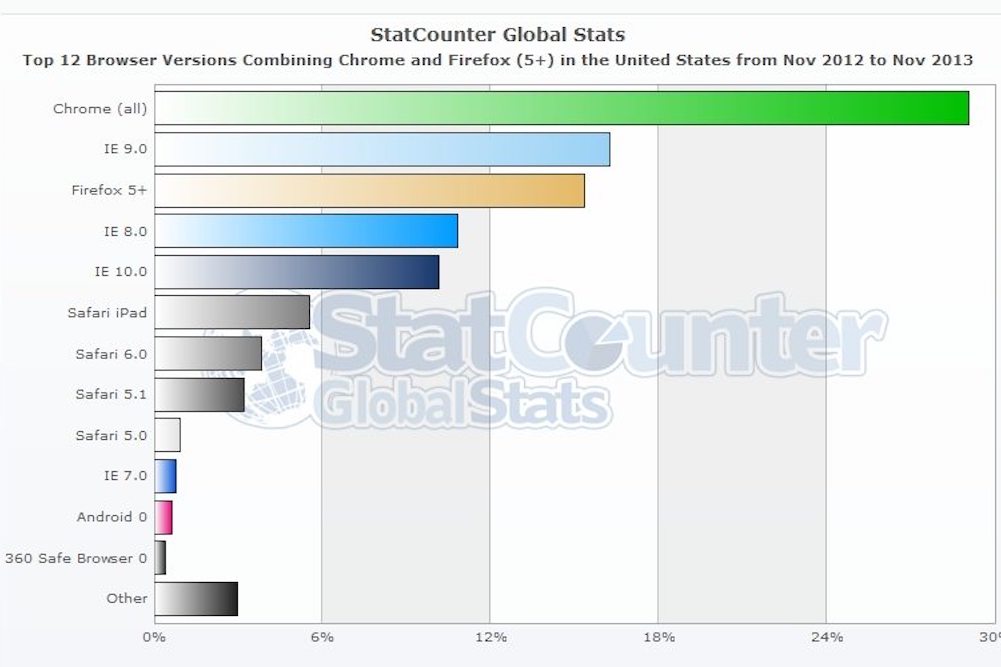 It’s not quite the new year yet, but North Star is making a resolution for 2014. No, we’re not going on a companywide diet, and we’re not doing a group membership to the gym (although it’s worth considering). But we are making a resolution we’ll definitely keep. As of January 1, 2014, we are officially dropping support for Internet Explorer 8 (IE8). Read on to learn why and to understand the benefits offered by modern browsers.
It’s not quite the new year yet, but North Star is making a resolution for 2014. No, we’re not going on a companywide diet, and we’re not doing a group membership to the gym (although it’s worth considering). But we are making a resolution we’ll definitely keep. As of January 1, 2014, we are officially dropping support for Internet Explorer 8 (IE8). Read on to learn why and to understand the benefits offered by modern browsers.
Constantly Changing
The one constant about the web is it’s always changing. The tools used to create the online experience, the methods and styles of web design, the types of devices used to access web content, and the software clients (i.e. browsers) have all vastly matured for the better. Some milestones, though, are more significant; they cause tectonic shifts in the online landscape. Even now, the web is undergoing another monumental renaissance as it shifts into embrace uniform standards, new methodologies to handle a wide array of devices, and heavier focus on user experience. Websites were once very limited in layout, design, and interactivity, but no longer.
The Browser Experience: Change at a Snail’s Pace
 However, just because a web application can be programmed doesn’t mean that all browsers will allow them to work as intended. In fact, a great deal of design and technical functionality is restricted by the limitations of browsers. Given the fact that the web has been around for consumer use since the early 1990s, browser innovations have come relatively slowly. This lethargic development has been due primarily to two factors: no unified adoption of standards and limited (or, in some cases, non-existent) automatic browser updates.
However, just because a web application can be programmed doesn’t mean that all browsers will allow them to work as intended. In fact, a great deal of design and technical functionality is restricted by the limitations of browsers. Given the fact that the web has been around for consumer use since the early 1990s, browser innovations have come relatively slowly. This lethargic development has been due primarily to two factors: no unified adoption of standards and limited (or, in some cases, non-existent) automatic browser updates.
The World Wide Web Consortium (W3C) has led the creation and codification of web standards internationally since 1994, but it is unable to force any entity to adopt them. Until a few years ago, the major players on the web, specifically browser developers, did not play nicely with each other. Microsoft, Google, and Mozilla all tried to create their own standards of development. Of course, such design by committee makes for a huge mess and stalls forward progress. Along with the introduction of the HTML5 and CSS3 standards (search Google if you want the tech details), the browser companies have had to concede that working together within a common standard is the only way to improve their bottom line.
Browsers never used to keep themselves updated, which is odd given the web’s inherent nature of change. Google Chrome has led the way in keeping itself automatically updated. Obviously, an ulterior motive is to ease the increase of market share (ultimately creating a web-based operating platform for its Google Apps offerings), but it addresses the bigger issue of incompatibility with new technology. Firefox and Safari don’t necessarily automatically update, but they at least prompt the user that an update is available.
Microsoft has, for whatever reason, been late to the game. Only within the last couple of years has Microsoft started auto-updating Internet Explorer on Windows Vista and above. The only hurdle still remaining is that a notable number of organizations still use Windows XP, which cannot support Internet Explorer above version 8.
The Old Kid on the Block
Internet Explorer 8 is the last bastion of old browser technology left, and, it needs to die gracefully. The clamor for its demise is not so violent as it was for IE6, but it is no less determined. This worn antique is preventing the advancement of the web and keeping users from experiencing the full glory of modern web design. Larger corporations, such as Google, have already dropped support as much as a year ago. Though the usage of IE8 is at 11% in the United States, we believe that it is in the best interests of those we serve to discontinue our support of it.
From a development perspective, it is costly to develop for and support IE8, as designers and programmers essentially have to create two versions of the same application: one that is built for modern browsers…and one that coddles the nuances of IE8.
North Star and Internet Explorer 8
So, with that background, here are several reasons why North Star will be dropping support for IE8 in January, 2014:
- IE8 is 3 versions behind the current release, which is 11.
- IE8 is holding users and our clients back from a new frontier of design and function.
- IE8 can dramatically increase the time and cost of development.
- IE8 is difficult to support a modern site on legacy browsers.
- Most major corporations are phasing out internal use and support of IE8.
With that said, we will not leave our clients out in the cold. We will review IE8 issues on a case-by-case basis to see if there is reasonable work-around, but we will no longer assure browser compatibility with IE8, as Microsoft is no longer providing direct support for this browser. Our aim is to help our clients move forward, not backward, and this means equipping them to embrace modern standards and long-term viability.
So, there you have it – one our 2014 resolutions! It’s not quite like losing weight…or, maybe it is? Because it will feel great to shed IE8. And maybe, with all the time we’ll save by not supporting an outdated browser, we’ll have time for a jog around the block….
Learn More About Website Development at North Star Marketing
To learn more about enhanced website development and responsive web design, we invite you to explore our website project gallery and marketing service offerings. Then give us a call at 336.229.6610 or send us an email to start the conversation. Thanks for reading the True North Blog!


